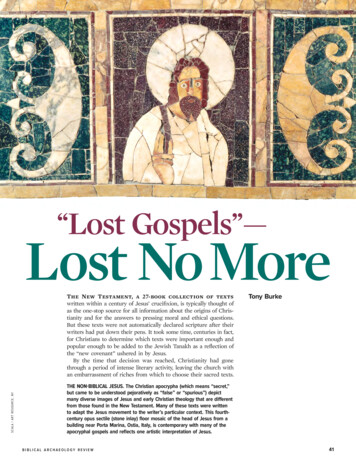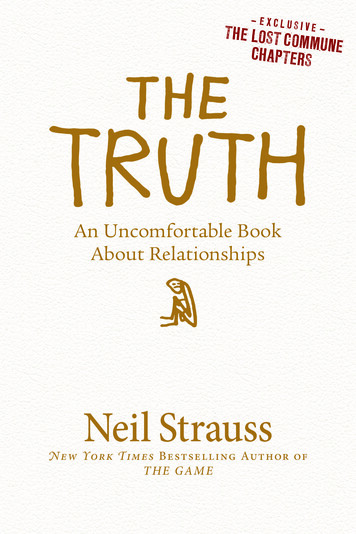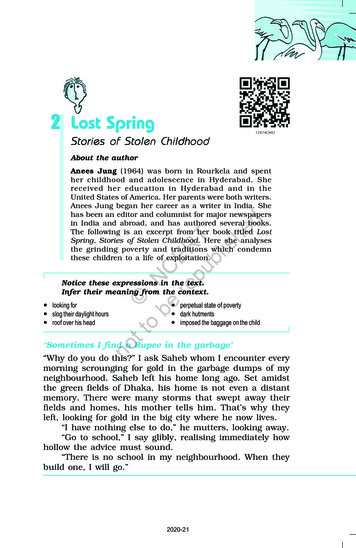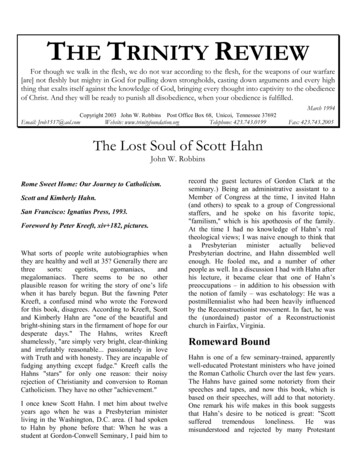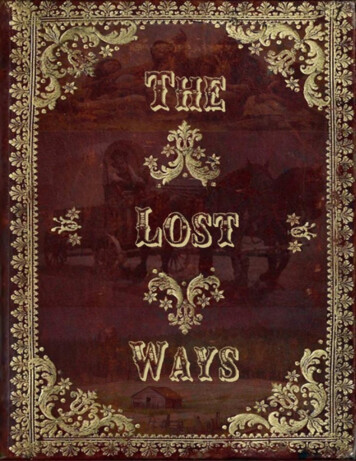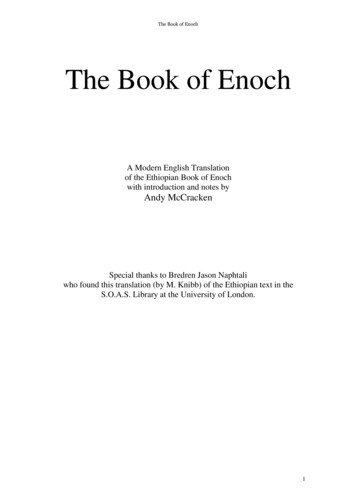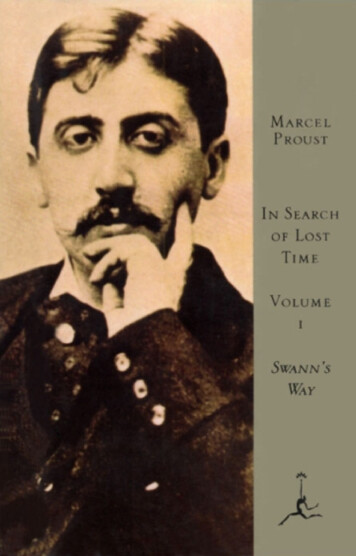
Transcription
MARCEL PROUSTMarcel Proust was born in the Parisian suburb ofAuteuil on July 10, 1871. His father, Adrien Proust, was adoctor celebrated for his work in epidemiology; hismother, Jeanne Weil, was a stockbroker’s daughter ofJewish descent. He lived as a child in the family home onBoulevard Malesherbes in Paris, but spent vacations withhis aunt and uncle in the town of Illiers near Chartres,where the Prousts had lived for generations and whichbecame the model for the Combray of his great novel. (Inrecent years it was officially renamed Illiers-Combray.)Sickly from birth, Marcel was subject from the age of nineto violent attacks of asthma, and although he did a year ofmilitary service as a young man and studied law andpolitical science, his invalidism disqualified him from anactive professional life.During the 1890s Proust contributed sketches to LeFigaro and to a short-lived magazine, Le Banquet,founded by some of his school friends in 1892. Pleasuresand Days, a collection of his stories, essays, and poems,was published in 1896. In his youth Proust led an activesocial life, penetrating the highest circles of wealth andaristocracy. Artistically and intellectually, his influencesincluded the aesthetic criticism of John Ruskin, thephilosophy of Henri Bergson, the music of Wagner, andvii
the fiction of Anatole France (on whom he modeled hischaracter Bergotte). An affair begun in 1894 with thecomposer and pianist Reynaldo Hahn marked thebeginning of Proust’s often anguished acknowledgment ofhis homosexuality. Following the publication of EmileZola’s letter in defense of Colonel Dreyfus in 1898, Proustbecame “the first Dreyfusard,” as he later phrased it. Bythe time Dreyfus was finally vindicated of charges oftreason, Proust’s social circles had been torn apart by theanti-Semitism and political hatreds stirred up by the affair.Proust was very attached to his mother, and after herdeath in 1905 he spent some time in a sanitorium. Hishealth worsened progressively, and he withdrew almostcompletely from society and devoted himself to writing.Proust’s early work had done nothing to establish hisreputation as a major writer. In an unfinished novel, JeanSanteuil (not published until 1952), he laid some of thegroundwork for In Search of Lost Time, and in AgainstSainte-Beuve, written in 1908-09, he stated as his aestheticcredo: “A book is the product of a different self from theone we manifest in our habits, in society, in our vices. If wemean to try to understand this self it is only in our inmostdepths, by endeavoring to reconstruct it there, that thequest can be achieved.” He appears to have begun work onhis long masterpiece sometime around 1908, and the firstvolume, Swann’s Way, was published in 1913. In 1919 thesecond volume, Within a Budding Grove, won theviii
Goncourt Prize, bringing Proust great and instantaneousfame. Two subsequent sections—The Guermantes Way(1920-21) and Sodom and Gomorrah (1921)—appeared inhis lifetime. (Of the depiction of homosexuality in thelatter, his friend André Gide complained: “Will you neverportray this form of Eros for us in the aspect of youth andbeauty?”) The remaining volumes were publishedfollowing Proust’s death on November 18, 1922: TheCaptive in 1923, The Fugitive in 1925, and TimeRegained in 1927.ix
CONTENTSNote on the Translation (1981) . viiiNote (1992) . xiiPart OneCOMBRAY. 1Part TwoSWANN IN LOVE . 221Part ThreePLACE-NAMES: THE NAME . 452Notes have been integrated into the text as footnotes.xiii
Note on the Translation (1981)C. K. Scott Moncrieff’s version of À la recherche du tempsperdu has in the past fifty years earned a reputation as one of thegreat English translations, almost as a masterpiece in its ownright. Why then should it need revision? Why tamper with awork that has been enjoyed and admired, not to say revered, byseveral generations of readers throughout the English-speakingworld?The answer is that the original French edition from whichScott Moncrieff worked (the “abominable” edition of theNouvelle Revue Française, as Samuel Beckett described it in amarvellous short study of Proust which he published in 1931)was notoriously imperfect. This was not so much the fault of thepublishers and printers as of Proust’s methods of composition.Only the first volume (Du côté de chez Swann) of the novel asoriginally conceived—and indeed written—was publishedbefore the 1914-1918 war. The second volume was set up intype, but publication was delayed, and moreover by that timeProust had already begun to reconsider the scale of the novel;the remaining eight years of his life (1914-1922) were spent inexpanding it from its original 500,000 words to more than amillion and a quarter. The margins of proofs and typescriptswere covered with scribbled corrections and insertions, oftenoverflowing on to additional sheets which were glued to thegalleys or to one another to form interminable strips—whatFrançoise in the novel calls the narrator’s “paperoles.” Theunravelling and deciphering of these copious additions cannothave been an enviable task for editors and printers.Furthermore, the last three sections of the novel (Laprisonnière, La fugitive—originally called Albertine disparue—and Le temps retrouvé) had not yet been published at the timeof Proust’s death in November 1922 (he was still correcting axv
typed copy of La prisonnière on his deathbed). Here the originaleditors had to take it upon themselves to prepare a coherent textfrom a manuscript littered with sometimes hasty corrections,revisions and afterthoughts and leaving a number of unresolvedcontradictions, obscurities and chronological inconsistencies. Asa result of all this the original editions—even of the volumespublished in Proust’s lifetime—pullulate with errors,misreadings and omissions.In 1954 a revised three-volume edition of À la recherchewas published in Gallimard’s Bibliothèque de la Pléiade. Theeditors, M. Pierre Clarac and M. André Ferré, had been chargedby Proust’s heirs with the task of “establishing a text of his novelas faithful as possible to his intentions.” With infinite care andpatience they examined all the relevant material—manuscripts,notebooks, typescripts, proofs, as well as the original edition—and produced what is generally agreed to be a virtuallyimpeccable transcription of Proust’s text. They scrupulouslyavoided the arbitrary emendations, the touchings-up, thewholesale reshufflings of paragraphs in which the originaleditors indulged, confining themselves to clarifying the textwherever necessary, correcting errors due to haste orinadvertence, eliminating careless repetitions and rationalisingthe punctuation (an area where Proust was notoriously casual).They justify and explain their editorial decisions in detailedcritical notes, occupying some 200 pages over the three volumes,and print all the significant variants as well as a number ofpassages that Proust did not have time to work into his book.The Pléiade text differs from that of the original edition,mostly in minor though none the less significant ways,throughout the novel. In the last three sections (the third Pléiadevolume) the differences are sometimes considerable. Inparticular, MM. Clarac and Ferré have included a number ofpassages, sometimes of a paragraph or two, sometimes of severalpages, which the original editors omitted for no good reason.xvi
The present translation is a reworking, on the basis of thePléiade edition, of Scott Moncrieff’s version of the first sixsections of À la recherche—or the first eleven volumes of thetwelve-volume English edition. A post-Pléiade version of thefinal volume, Le temps retrouvé (originally translated byStephen Hudson after Scott Moncrieff’s death in 1930), wasproduced by the late Andreas Mayor and published in 1970;with some minor emendations, it is incorporated in this edition.There being no indication in Proust’s manuscript as to where Lafugitive should end and Le temps retrouvé begin, I havefollowed the Pléiade editors in introducing the break some pagesearlier than in the previous editions, both French and English—at the beginning of the account of the Tansonville episode.The need to revise the existing translation in the light of thePléiade edition has also provided an opportunity of correctingmistakes and misinterpretations in Scott Moncrieff’s version.Translation, almost by definition, is imperfect; there is always“room for improvement,” and it is only too easy for thelatecomer to assume the beau rôle. I have refrained fromofficious tinkering for its own sake, but a translator’s loyalty isto the original author, and in trying to be faithful to Proust’smeaning and tone of voice I have been obliged, here and there,to make extensive alterations.A general criticism that might be levelled against ScottMoncrieff is that his prose tends to the purple and theprecious—or that this is how he interpreted the tone of theoriginal: whereas the truth is that, complicated, dense,overloaded though it often is, Proust’s style is essentially naturaland unaffected, quite free of preciosity, archaism or selfconscious elegance. Another pervasive weakness of ScottMoncrieff’s is perhaps the defect of a virtue. Contrary to awidely held view, he stuck very closely to the original (he isseldom guilty of short-cuts, omissions or loose paraphrases),and in his efforts to reproduce the structure of those elaboratexvii
sentences with their spiralling subordinate clauses, not onlydoes he sometimes lose the thread but he wrenches his syntaxinto oddly unEnglish shapes: a whiff of Gallicism clings to someof the longer periods, obscuring the sense and falsifying thetone. A corollary to this is a tendency to translate French idiomsand turns of phrase literally, thus making them sound weirder,more outlandish, than they would to a French reader. Inendeavouring to rectify these weaknesses, I hope I havepreserved the undoubted felicity of much of Scott Moncrieffwhile doing the fullest possible justice to Proust.I should like to thank Professor J. G. Weightman for hisgenerous help and advice and Mr D. J. Enright for his patientand percipient editing.TERENCE KILMARTINxviii
Note (1992)Terence Kilmartin intended to make further changes to thetranslation as published in 1981 under the title Remembrance ofThings Past. But, as Proust’s narrator observed while reflectingon the work he had yet to do, when the fortress of the body isbesieged on all sides the mind must at length succumb. “It wasprecisely when the thought of death had become a matter ofindifference to me that I was beginning once more to fear death . . as a threat not to myself but to my book.”C. K. Scott Moncrieff excelled in description, notably oflandscape and architecture, but he was less adroit in translatingdialogue of an informal, idiomatic nature. At ease withintellectual and artistic discourse and the finer feelings, and alertto sallies of humorous fantasy, he was not always comfortablewith workaday matters and the less elevated aspects of humanbehaviour. It was left to Kilmartin to elucidate the significanceof Albertine’s incomplete but alarming outburst—“. . . me fairecasser . . .”—in The Captive, a passage Scott Moncrieffrendered totally incomprehensible, perhaps throughsqueamishness, perhaps through ignorance of low slang. Othermisunderstandings of colloquialisms and failures to spotsecondary meanings remained to be rectified. And some furtherintervention was prompted by Scott Moncrieff’s tendency tospell out things for the benefit of the English reader: anadmirable intention (shared by Arthur Waley in his Tale ofGenji), though the effect could be to clog Proust’s flow andmake his drift harder to follow.The present revision or re-revision has taken into accountthe second Pléiade edition of À la recherche du temps perdu,published in four volumes between 1987 and 1989 under thedirection of Jean-Yves Tadié. This both adds, chiefly in theform of drafts and variants, and relocates material: not alwaysxix
helpfully from the viewpoint of the common (as distinct fromspecialist) reader, who may be surprised to encounter virtuallythe same passage in two different locations when there wasdoubt as to where Proust would finally have placed it. But thenew edition clears up some long-standing misreadings: forexample, in correcting Cambremer’s admiring “niece” in TimeRegained to his “mother,” an identification which accords witha mention some thousand pages earlier in the novel.Kilmartin notes that it is only too easy for the latecomer,tempted to make his mark by “officious tinkering,” to “assumethe beau rôle.” The caveat, so delicately worded, is one to take toheart. I am much indebted to my wife, Madeleine, withoutwhose collaboration I would never have dared to assume a rolethat is melancholy rather than (in any sense) beau.D. J. ENRIGHTxx
Part OneCOMBRAYFIor a long time I would go to bed early. Sometimes, thecandle barely out, my eyes closed so quickly that I did nothave time to tell myself: “I’m falling asleep.” And half anhour later the thought that it was time to look for sleepwould awaken me; I would make as if to put away thebook which I imagined was still in my hands, and to blowout the light; I had gone on thinking, while I was asleep,about what I had just been reading, but these thoughtshad taken a rather peculiar turn; it seemed to me that Imyself was the immediate subject of my book: a church, aquartet, the rivalry between François I and Charles V.This impression would persist for some moments after Iawoke; it did not offend my reason, but lay like scalesupon my eyes and prevented them from registering thefact that the candle was no longer burning. Then it wouldbegin to seem unintelligible, as the tho
active professional life. During the 1890s Proust contributed sketches to Le Figaro and to a short-lived magazine, Le Banquet, founded by some of his school friends in 1892. Pleasures and Days, a collection of his stories, essays, and poems, was published in 1896. In his youth Proust led an active social life, penetrating the highest circles of wealth and aristocracy. Artistically and .
